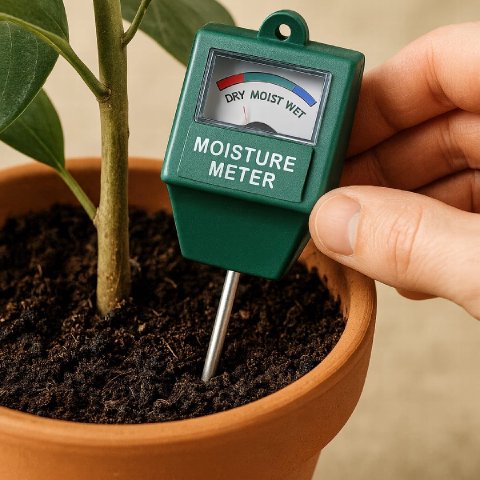To use a moisture meter, insert its probe about two-thirds of the way into the pot's soil, midway between the stem and the edge. Wait 60 seconds for a stable reading. Water succulents when the meter reads 'Dry' (1-3), most tropical plants when it's 'Moist' (4-5), and moisture-lovers like ferns when it's still in the upper 'Moist' range (6-7). Always wipe the probe clean after each use for accurate results.
🪴 In This Guide 🪴
Getting ready for cooler, darker days? Our Autumn Houseplant Care Checklist shows how to adjust watering and use tools like moisture meters through the season.
🤔 Why a Moisture Meter is a Game-Changer
A moisture meter doesn’t magically make you a plant expert, but it’s an incredible learning tool. If you’re just starting out with plants, you might also find our beginner’s essential tools guide helpful for building your plant care toolkit. The meter helps you:
- Eliminate Guesswork: It gives you a simple number instead of a vague feeling of “damp or not damp?”
- Prevent Overwatering: It’s a reliable second opinion that will stop you from watering a plant whose soil is still wet at the root level, even if the top feels dry.
- Check Large Pots: It’s the only practical way to know the moisture level deep down in a large pot where your finger can’t reach.
- Learn Faster: By consistently checking the soil, you’ll start to learn the rhythm of how quickly each of your plants dries out in your specific environment.
🔧 How to Use a Moisture Meter in 4 Simple Steps
Most common meters are analog and don’t require batteries. They work by measuring the electrical current between two metals in the probe-a current that flows easily through wet soil and poorly through dry soil.
Step 1: Insert the Probe Correctly
Gently insert the metal probe into the soil, aiming for a depth that is about two-thirds of the way down the pot. For placement, go about halfway between the plant’s main stem and the edge of the pot. This avoids the dense central root ball and the quickly-drying soil at the very edge.
Step 2: Wait for the Reading to Settle
Don’t trust the initial reading. The needle will often jump around at first. Leave the meter in the soil for about 60 seconds to allow the reading to stabilize and give you an accurate measurement.Step 3: Read the Dial and Decide
The dial is typically numbered 1 (bone dry) to 10 (soaking wet). Use the chart below to interpret the results for your specific plant type.Step 4: Remove and Clean the Probe
This is the most important step! After every use, pull the meter out and wipe the probe completely clean and dry with a cloth. This prevents corrosion on the sensor, stops you from transferring any soil pathogens between plants, and ensures your meter stays accurate for years.
📊 Interpreting the Results: What the Numbers Mean
Not all plants have the same thirst. Use this general guide to know when to water based on your meter’s reading.
| Reading | Level | Plant Examples | Action |
|---|---|---|---|
| 1 – 3 | DRY | Cacti, Succulents, Snake Plants, ZZ Plants | Time to Water! These plants need to dry out completely between waterings. |
| 4 – 5 | MOIST | Monsteras, Philodendrons, Pothos, Fiddle Leaf Fig | Time to Water! This is the sweet spot for most common tropical houseplants. |
| 6 – 7 | MOIST | Ferns, Calatheas, Peace Lily, Alocasia | Check again soon. These plants prefer consistently moist (but not wet) soil. Water as the needle approaches 5 or 6. |
| 8 – 10 | WET | None (unless it’s an aquatic plant) | DO NOT WATER! The soil is saturated. Check for drainage issues if it stays this high for more than a day. |
❓ Frequently Asked Questions
Are soil moisture meters accurate?
For home use, they are very accurate for determining relative moisture levels. They work by measuring electrical conductivity, not the actual water volume, so they are a fantastic guide. Their accuracy can be reduced in very chunky, airy, or salty soil. Always use them as a tool to confirm your judgment, not replace it entirely.Do I need to buy an expensive moisture meter?
No, not at all. For most houseplants, the simple, inexpensive analog meters (the ones with a single probe and no batteries) work perfectly well and are very reliable.Why is my moisture meter always reading 'Dry' even after I water?
This can happen if the soil is extremely compacted or has become hydrophobic (so dry it repels water). It can also happen if the probe isn’t making good contact with the soil. Try aerating the soil with a chopstick and then do a thorough bottom watering to rehydrate the entire soil mass.Can I leave the moisture meter in the plant pot?
You should not. The sensors on the probe are delicate and can corrode if left in damp soil for extended periods. This will quickly ruin the meter and make its readings inaccurate. Always insert, read, and remove.Does a moisture meter work for all types of soil?
It works best in standard potting mixes. In extremely chunky mixes (like orchid bark) or very gritty mixes (like for some cacti), the probe may not make enough contact with moisture-retaining particles to give a reliable reading. In those cases, the ’lift test’ or the weight of the pot is a more reliable method.👉 Master the Basics: The Ultimate Guide to Watering Houseplants












